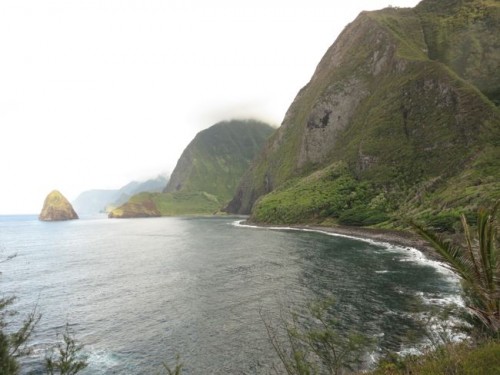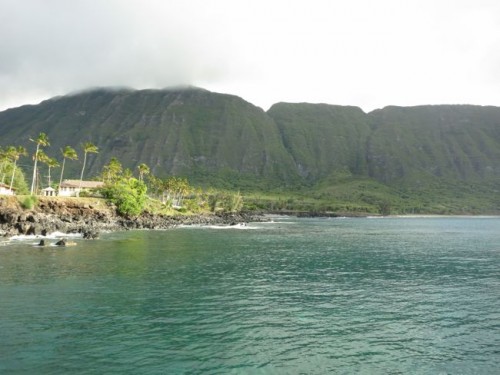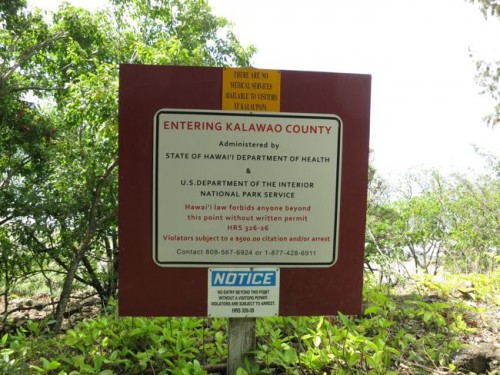The following post is probably the longest post I have ever written, and certainly the hardest. I find it very difficult to talk and write about the things that are closest to me.
This is a story that needs to be told, but I didn’t know where to start. I guess I’ll start where the story usually starts for me, and hope I can tell it properly from there.
When people hear I am from Moloka’i, Hawai’i, they have one of two reactions. Either they say “Moloka’i? Which one is that?” or they say “Moloka’i!?! Really!?! The one with the leper colony?”
And it’s true. My island is known first and foremost because of its unusual and tragic history: because Kalaupapa peninsula was used as a place to banish patients suffering from Hansen’s Disease (to use its proper, medical, name), a place to isolate them from society for fear they would spread their affliction to the rest of the population.
Moloka’i lies in the middle of the Hawaiian archipelago, middle in age and middle in size. The island is shaped like a dolphin: curving its flippers out on the dry western end, its mouth on the wetter side of the island marked by the valley of Halawa. Along the stomach of the dolphin lie deep valleys and steep cliffs plummeting over 3,000 feet into the sea. Spread out at the base of these cliffs is Kalaupapa peninsula: a flat stretch of land punctuated by the rise of Kauhako crater, a small shield volcano which erupted long after the rest of the island had been formed, creating the peninsula.
In ancient times and the 19th century the only access to the peninsula was via a steep, treacherous trail up the cliff-face, or by sea. In the 1840s and ’50s the entire peninsula planted in sweet potatoes which were shipped off to California to feed hungry gold miners. When the gold rush boom died off the farmers began to move away from the peninsula. At the same time, Hawai’i experienced a health crisis. The population of the kingdom had already been devastated by outbreaks of smallpox, influenza and other infectious diseases that the Polynesians had no natural immunity against. Now a new threat loomed: leprosy.
In the 19th century leprosy was a poorly misunderstood disease, and the stigma against it was enormous. When the disease began to spread among Hawaiians, the country went into panic mode. Beginning in 1864 Kalaupapa peninsula was cleared of all its former residents and in 1866 islanders diagnosed with leprosy were sent on a one-way trip to the peninsula: never to return to their former lives, and never to see their family and friends again.
Tragically, what 19th century doctors didn’t know is that leprosy, despite its terrible historical reputation, is not an easy disease to catch. Between 93-95% of the world’s population is naturally immune to Hansen’s disease (yes, that means they can’t catch it under any circumstances). Even the 5-7% who are susceptible to the disease are only likely to catch it after extended exposure. Unfortunately the stigma against leprosy means that people are reluctant to seek treatment, increasing the chances of spreading it to family members. And particularly unfortunately for Hawaii, Pacific Islanders are one of the ethnic groups most susceptible to leprosy. Even so, it’s quite likely that many of those who were sent to Kalaupapa peninsula did not actually have Hansen’s disease: there was no actual diagnostic test, and skin cancer, eczema, syphilis (at the time, leprosy was thought by some doctors to be a form of syphilis) and a number of other skin ailments could be easily mistaken for the dreaded disease.
When Kalaupapa was first made a leper colony the Kingdom of Hawaii was in such a panic over the disease that little provisions were made for the sufferers: no houses were built, no hospital was established, no doctors or medical supplies were sent to assist the patients. Instead, they were deposited at Kalawao, a cold, damp settlement tucked at the base of the cliffs. They were sent without food as it was hoped they would grow their own supplies, but most were too ill, and the cold climate and lack of sun conspired against those who tried, or medical supplies.
The suffering of the earliest patients at Kalawao was immense: written accounts from the period tell of patients dying of pneumonia and starvation, begging for poi (fermented taro, the staple of the Hawaiian diet) with their last breath. The settlement was completely lawless, and stronger patients took advantage of weaker patients. Children and the elderly (the youngest patient sent to Kalawao was 6, the oldest 104) and those in advanced stages of the disease had no hope of survival. Their only hope was that a family member would make the ultimate sacrifice, and would go into exile with them as a ‘kokua’ or helper.
Just getting to the peninsula could be a hazard. In one notorious instance a storm came up as the boat carrying a new load of patients approached the rocky landing at Kalawao, and the boat was unable to dock. The captain panicked, and, unwilling to carry the patients back to Honolulu, ordered them to be thrown over the side, forcing them to swim to the rocky shore in the heavy seas. Not everyone made it.
Devastated by the situation on the peninsula, and facing public outcry over situations like the one above, the government sought desperately to improve life for the patients, but the fear of leprosy was so great that it was almost impossible to convince anyone to work on the peninsula to support the patients there. Finally the Catholic church found four priests who volunteered to serve in the colony in rotation, to limit their chances of catching the dread disease. On May 10, 1873 the first priest, Father Damien, arrived at the settlement, and, at his own request, stayed there permanently.

Father Damien with the Kalawao Girls Choir, at Kalaupapa, Moloka’i, circa 1870s, via Wikimedia Commons
Damien was more than a priest: he built houses, bandaged wounds, grew food, and dug seemingly endless graves. His presence helped to create a community, and inspired others who came to serve and help. A dozen years after he arrived he contracted leprosy himself, and in 1889 he passed away from its effects.
Damien’s legacy made the peninsula a much more pleasant place to live, with churches, hospitals, homes for children who were sent to the peninsula without their parents, and entertainment facilities. In 1907 Jack London visited the peninsula, and wrote an article in defense of its civility, describing races and fun, the prosperous residents, the humane treatment, and the relative safety of exposure to leprosy.
Still, for all these amenities, for all its beauty, the peninsula was a place of exile, a prison.
It would remain a prison for most of the 20th century, with those suffering from Hansen’s disease being sent there well into the 1940s, even after the introduction of effective drugs for treating the disease. Only in 1969 were patients allowed to move away from peninsula, and by then, many of the remaining patients had spent almost their entire life on the peninsula, and did not want to leave. After some discussion, most of the patients stayed in the prison that had become their home. Some moved away, some ventured out for visits, some never left at all. At their request, the peninsula will become a national park once the last patient passes away. When I was born there were over 75 patients: now there are 13, seven of whom live permanently at Kalaupapa.
As well as a national park, Kalaupapa will always be a memorial, and its now a sacred site: Father Damien was made Saint Damien of Moloka’i, and the first nun to serve at Kalaupapa, Mother Marianne, will become Saint Marianne this October.
For me, and for every child growing up on Moloka’i, the story of Kalaupapa and Kalawao was as much a part of my childhood mythology and history as Disney’s Cinderella is for most other children. We knew the story of Father Damien, visited the churches he built on the ‘topside’ portion of the island, took annual school field trips to the lookout at the top of the pali, with its views out over the peninsula, and knew more about Hansen’s disease than any other 10 year olds in the US.
But for all I grew up with the story, I never got to visit the peninsula. Kalaupapa used to keep people in: now it keeps people out. Access is still incredibly difficult: by air, by sea, or by that same trail up the steep cliff-face. And even with a boat, a plane ticket or really good knees, you can’t just visit Kalaupapa. Children younger than 16 are not allowed to visit the peninsula, and even adults can only visit either as part of an official tour or with an invitation from a resident of the peninsula. I couldn’t afford the first, and an opportunity for the second never arose.
Until this trip. During my last visit home I was privilege enough to have the opportunity to go down to Kalaupapa, and even stay the night. It was an experience that is almost indescribable, but I’ll try my best to tell you about it tomorrow.
For now, if you want to know more, the National Park service has an excellent website, particularly the page with quotes from patients.










Wow. Thank you for sharing that incredible history with us. I had no idea that such a place/situation even existed. It was incredibly sad to read about, but it’s definitely a story that needs to be told.
OMG. I had no idea this ever happened there! I love hearing about history because things like this can’t be forgotten. I’m glad you shared 🙂
hanahou.comkmeb.orgcbsnews.comDo you know Makia Malo? He is a story teller, and the youngest resident there. I used to help him a little bit during his visits to Oahu with Dominique and Jeff the Storyteller. Makia’s dog is named Maka.
I’d like to share a little about his history:
Makia was 13 when he was forcefully taken from his home. He was put in a guarded prison to await transport to Kalaupapa. He tried to escape, and it caused an island panic. Imagine, a 13-year-old boy, scared, and now alone being hunted by the authorities.
Makia spoke no Hawaiian when he reached the colony, and had to learn because it was the main language at the time. (His service dog is trained to Hawaiian cues) There are some details I forget, but the result was that he fell into a depression, and stopped taking his medication. He lost his eyes and fingertips as a result.
But that didn’t stop him from later marrying, and traveling the world with my friend Jeff. Only a few years ago, he went to the Mainland to participate in a Storytelling Festival.
Makia is a professional storyteller. Some of his stories are traditional stories preserved from folklore, other stories are about residents, and still others are of his own creation.
I lost track of a lot about Hawaii when I moved in 2008. I don’t know where Makia is, but I love knowing that I had the chance to hug him.
Since he has made himself a lovely public figure, here are some stories about him.
http://www.hanahou.com/pages/magazine.asp?Action=DrawArticle&ArticleID=355&MagazineID=22
http://www.kmeb.org/wordpress/?p=68
http://www.cbsnews.com/2100-204_162-545392.html
What a sad story. It shows the worst and the best of human behaviour.
Terrible things still happen today, but we have come so far in our expectations of our behaviour towards the sick and the weak. What was done when people were so afraid of catching leprosy! Growing up with Kalaupapa over the hill must have been quite something. I’m glad you finally had the chance to go there and to spend some time there, and I look forward to hearing about it. Thank you for sharing something so close to home.
I have just been reading Kate Adie’s book, “Nobody’s Child”, about the treatment of foundlings. I strongly recommend this book. Very, very sad. So many well-intentioned efforts to look after the babies foundered in the face of demand and of poor funding. Jamming babies into poorly staffed homes or hospitals resulted in appalling mortality rates – up to ninety per cent died in some hospitals before reaching the age of five. This was only just over a hundred years ago. We have come a long way, though we are still working on the way we treat the vulnerable.
This is powerful writing, Dreamstress, and the pictures! That mountain, rising up like a rounded wall, the mists, the tall bending palms. The black rocks, onto which newly arriving patients must have had to climb. The 19th century pictures. You have brought a place alive for us, a place many of us had no notion of. Now we do, and it’s a heavy, haunting, need-to-know thing. Disease stigmas continue today: elephantiasis, AIDs, so many more…
Very best,
Natalie
It is a very good post. Thank you for sharing the story with us all. There were very sad times in US history–in all history, of course–but we need to remember it so that we can remember to be kinder in the future. Every little bit of kindness adds up.
What a lovely way of putting it. Thank you Elise.
Thank you. I had hoped I’d be able to give the story its due. In addition to the visual stigmas, there are other diseases that have stigmas: depression in particular. Everyone who fights cancer is a hero, but who has ever said that about someone with a mental illness? Those are the ones that really get me.
I never knew. Thank you for sharing
Great, well written post. It even has a cliffhanger.
Waiting for the rest of the story.
Thank you for telling this story. I never heard it and found it very interesting!
You’re welcome. I’m glad to share it – it’s such an integral part of Hawai’is history that is usually left out of the Hawaii story and the visitor experience.
I saw a young lady who had Hansen’s disease this year. It’s still absolutely rife in 3rd world countries, despite the WHO funding all drug treatment.
Even I was surprised to find out how difficult it is to catch. This lady had lived with her boyfriend, who also had it, for a year before catching it.
The loss of nose, fingers, toes etc is what caused lots of the stigma in the past, it’s unsightly. But they don’t ‘rot away’, it’s just that you lose feeling in your extremities, and bump, scrape, stub, or get frostbite on those parts and don’t notice it. Nowadays this doesn’t have so much stigma because exactly the same thing happens with poorly controlled Type II Diabetes. I remember thinking that T2DM is the Leprosy of our age…..
Our lady was treated with lots of respect. But I’m sure that if the general public knew she had Leprosy, she would have been ostracised and driven out from the community.
Thank you for sharing your experience.
Yes, the ‘fingers & toes falling off’ is one of the terrible, persistent myths of Hansen’s disease. In addition to the potential of infection in unnotticed injuries, Hansen’s disease itself causes lesions and ulcers which may need to be removed.
As a Belgian and citizen of Leuven, the town where father Damien rests, I’m very familiar with his story, as are all people from my country. If there is one island in Hawai’i that everyone here knows, it’s Moloka’i. His life is still an inspiration for us and he was voted greatest Belgian a couple of years ago. It was very moving to read your post and I’m looking forward to read about your stay at the colony.
Ah, I had wondered if I had any Belgian readers. I’ve heard many times about how amazing it is to be a Moloka’ian visiting Belgium, and know what a connection there is between the two far-flung places. Thank you for sharing your side of the story.
This is fascinating. I had no idea about any of this.
I originally came to your blog for the sewing, and am so intrigued by this story which I too had never heard. To think that a mutual love of sewing led to me learning about this! Thankyou for sharing it with us.
One of the many things I love about the blog world is that it has introduced me to so many new stories, and so much information I would never have thought to go looking for on my own. It’s fabulous there are all these blogs I follow that are connected by a common thread, but that we all have our own lives and interests beyond historical fashion and sewing. It’s a great experience-broadener for me, which is why I try to share a wider segment of the things I care about. I’m glad you have enjoyed this. 🙂
Leimomi, when I saw the book on Molokai in the library, I was secretly hoping for the story that you shared above. The history of Moloka’i and most importantly, how the island’s history influences *your* history.
I’m so glad you shared. You’re a wonderful storyteller: you express yourself with both objectivity and sensitivity. And the photos you included were haunting and poignant.
I look forward to reading your next post.